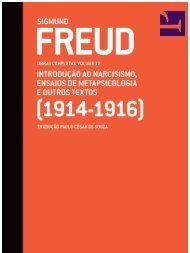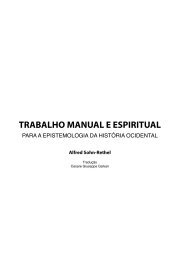Perversion the Social Relation
Perversion the Social Relation
Perversion the Social Relation
- No tags were found...
You also want an ePaper? Increase the reach of your titles
YUMPU automatically turns print PDFs into web optimized ePapers that Google loves.
Fatal West 377 For a good summary of <strong>the</strong> relation of fantasy to sexuality, see Teresa de Lauretis,81-85.8 Philip Kuberski's "Hard Copy" has developed <strong>the</strong> metaphor of viral information in<strong>the</strong> late 20 th century to speculate on <strong>the</strong> relation between computers, ideology, andsubjectivity. Commenting on <strong>the</strong> film Blade Runner, he notes <strong>the</strong> murderous rage ofone replicant who destroys his creator: "This scene dramatizes <strong>the</strong> film's major concern:what precisely does a man do when he learns, as has postmodern man, that hissubjectivity is an artefact of society, and that his body is <strong>the</strong> accidental product ofmutation and <strong>the</strong> manifestation, like a computer or a television, of Information" (70).The dilemma is that this man, constituted of information, should be both superiorto "natural" men and yet inhumanly, abjectly inferior.9 Lacan introduces <strong>the</strong> "lamella" to identify "<strong>the</strong> relation between <strong>the</strong> living subjectand that which he loses by having to pass, for his reproduction, through <strong>the</strong> sexualcycle" (1978:199). Sexual reproduction means that <strong>the</strong>re is something in us that isnot us, that is unconcerned with <strong>the</strong> fate of <strong>the</strong> individual subject. The mortal subjectlives with <strong>the</strong> undead of replication.n10 Compare with Wallace Stevens's "Snowman," who "nothing himself, beholds/ Nothingthat is not <strong>the</strong>re, and <strong>the</strong> nothing that is." See also Brian Rotman's brilliant analysisof nothing, Signifying Nothing: The Semiotics of Zero. In this book, he traces variousways in which nothing has served both a productive and disturbing function in<strong>the</strong> Western world.The interpretations o<strong>the</strong>r Cities of <strong>the</strong> Red Night gave to <strong>the</strong> words are:The city of partisans: "Here, everything is as true as you think it is and everythingyou can get away with is permitted."The university city: "Complete permission derives from complete understanding."The cities of illusion: "Nothing is true and <strong>the</strong>refore everything is permitted."(158-59)12 This is an idea I develop in chapter 5 of my Sublime Enjoyment.13 See "Introduction" of my Sublime Enjoyment.14 The "cut-in" or "cut-up" in Burroughs^ own work and in that of his character ClemSnide involves assembling information (taped sounds, news clippings, etc.) cut at randomfrom some source. Burroughs describes it:The cut-up method brings to writers <strong>the</strong> collage, which has been used by paintersfor fifty years. And used by <strong>the</strong> moving and still camera. In fact all street shots frommovie or still cameras are by <strong>the</strong> unpredictable factors of passersby and juxtapositioncut-ups. And photographers will tell you that often <strong>the</strong>ir best shots are accidents... writers will tell you <strong>the</strong> same. The best writing seems to be done almostby accident but writers until <strong>the</strong> cut-up method was made explicit—all writing isin fact cut-ups .. .—had no way to produce <strong>the</strong> accident of spontaneity. You cannotwill spontaneity. But you can introduce <strong>the</strong> unpredictable spontaneous factorwith a pair of scissors. (1982: 35)15 See o<strong>the</strong>r chapters of my Sublime Enjoyment, especially chapter 1.








